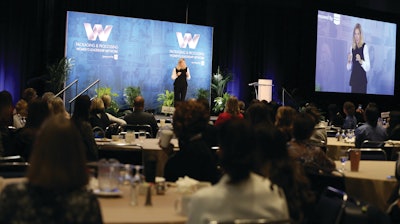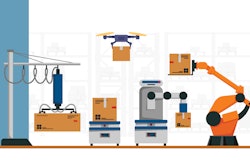It was a big moment for the packaging industry.
A record-breaking crowd, the vast majority of them women, came together for the Packaging & Processing Women’s Leadership Network breakfast at PACK EXPO International in Chicago last October.
The nearly 1,000 people in attendance heard Dawn Hudson, former president and CEO of Pepsi Cola North America and former chief marketing officer of the National Football League, deliver a keynote address about just how important it is to dismantle gender bias in the workplace and have women at the forefront of business.
It was an energizing and inspiring talk. While the attendees didn’t walk away having solved the challenges that women face in the traditionally male-dominated world of packaging and processing, they certainly demonstrated there is strength in numbers when it comes to tackling the obstacles ahead.
The reality is that women play an essential and growing role in just how successful companies will be. Their time, talents, insights and efforts are critical to achieving the results that companies are seeking.
Yet, despite making up a significant portion of the workforce, women continue to face historical challenges and discrimination that limit their opportunities for advancement, hinder their ability to succeed and discount the potential contributions they can bring to companies. That breakfast in Chicago, with its overflow capacity and lively conversations, could mark a turning point.
Closing the Gender Gap at Work
Despite years of progress, there’s still a significant gender gap in the packaging industry. Women make up nearly half (47%) of workers in all industries, according to the U.S. Bureau of Labor Statistics, but in packaging and processing, the number is closer to 35%.
Closing that gap is more than simply the right thing for companies to do. It’s imperative to their success. According to a study by consulting firm Deloitte and the Manufacturing Institute, manufacturers will need to hire 4 million workers by 2030 to avoid critical skill and workforce shortages. It’s not just a future need. According to one estimate from the National Association of Manufacturers, there was an average of 860,600 job openings per month in 2022.
Simply increasing the number of women in the manufacturing sector by a few percentage points would help fill almost every open job. But doing that will require addressing longstanding workforce inequalities. To start, there’s the gender pay gap.
Women in the industry earn significantly less than their male counterparts, with one recent study from the Institute of Packaging Professionals showing women trail men by 22%, a gap that is actually growing despite increasing awareness of the issue. This pay gap is a result of a number of factors, including discrimination and bias in the hiring and promotion processes, as well as the fact that women are often relegated to lower-paying positions within the industry.
Beyond the pay gap, women in the packaging and processing industry often face discrimination and harassment in the workplace. This reality can also make it more difficult for women to speak up and advocate for themselves and others, further hindering their ability to succeed in the industry.
Kelly Murosky, sustainable packaging manager at London, U.K.-based Unilever, shared how as a young engineer she sometimes felt that her ideas were overlooked. Rather than look elsewhere, she opted to double down.
“These experiences taught me to be more vocal and, most importantly, have confidence in yourself,“ she said. “If you have confidence in your ideas, others will be more likely to trust in your expertise.”
Another issue in the packaging and processing industry is that work conditions simply aren’t friendly to women. A 2021 Deloitte analysis found that women are 1.8 times more likely to leave the manufacturing industry than men. Lack of work/life balance and a dearth of flexible working opportunities are the primary culprits. Long hours and nights and weekends make it difficult to balance work and personal lives, leading to burnout.
Flexible work will be a competitive advantage for organizations willing to consider future-oriented work practices, said Rachael Tomasello, global director of strategic capabilities at McLean, Va.-based Mars, Inc.
“Flexibility looks different for everyone, and focusing on the unique needs of women in your leadership pipeline will ensure the talent moves into those leadership positions,” she said.
Overcoming the Obstacles to Women’s Progress
Despite these challenges, women in the packaging and food processing industry have made significant strides in recent years. Women have taken on leadership roles and have become successful business owners and executives in the industry. Additionally, organizations and advocacy groups have been working to promote gender equality and support women in the industry, providing them with resources and opportunities to succeed.
The Packaging & Processing Women’s Leadership Network, or PPWLN, connects women in the industry and provides them with the support and resources they need to succeed. PPWLN also offers mentorship programs, networking events, and leadership development opportunities to help women in the industry advance their careers.
Opening up these kind of career opportunities and development experiences to more people leads to more women taking on prominent and influential roles in the industry, even if they don’t come from a packaging or engineering background. Allison Lin, global vice president of packaging sustainability at Mars, Inc., described how she quickly realized a job on Wall Street wasn’t the right career path for her following an early internship.
“Luckily, Procter & Gamble was recruiting on campus, and I entered the world of packaging, which I knew nothing about at the time,” she said. She fell in love with the field of sustainable packaging, and eventually led the company’s global recycled and bio-based plastics sourcing strategy before taking on roles at Starbucks, Coca-Cola and now Mars.
“We need to focus on educating and promoting the work we do to the next generation of female talent, and then ensure that we’re creating an environment where diverse backgrounds are welcomed and valued so that talent can be retained and represented at all levels,” Lin said.
Overall, the experience of women in the packaging and processing industry has been marked by challenges and discrimination, but also by resilience and determination. Despite the obstacles they have faced, women have made significant strides and have become leaders in the industry. With the support of organizations like PPWLN, and continued efforts to promote gender equality, women in the industry can expect to continue to break down barriers and succeed.
And as the manufacturing industry sheds its reputation as a dark or dirty place to work, there is a growing set of professional job opportunities in the field—from engineering to package design to sustainability-focused roles to plant floor operations. The packaging industry is on the forefront of technological innovation, and women can and should be at the lead.
As that breakfast in Chicago showed, the talent, energy and commitment to make it happen is there. It’s up to the industry to seize the opportunity to make real change.



























